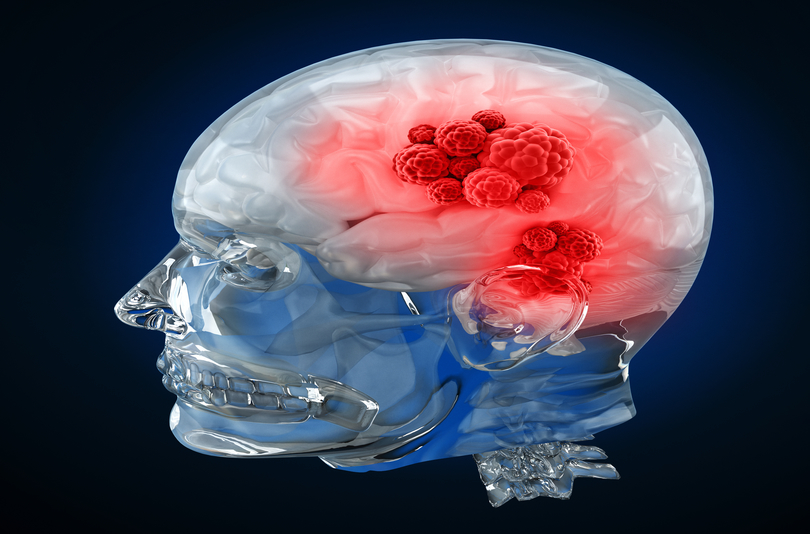A brain cancer is an abnormal growth that originates in the brain or a metastatic tumor that has migrated from tumor cells that have originated in other distant parts of the body. It may occur in any tissue contained in the skull, including the brain, the cranial nerves, the meninges, pituitary gland, and the pineal gland.

Doctors diagnose brain tumor by conducting the neurological exam and tests like MRI, CT scan, and biopsy. Read more on brain tumor diagnosis here.
Treatment options need to be explored after watchful waiting and they include surgery. Radiotherapy, chemotherapy and targeted therapy. A combination of the different types of treatment procedures is usually prescribed. Read more on Treatment for Brain Cancer here
Patients most commonly present with signs of intracranial pressure (e.g., headache, mood swings, nausea, vomiting and gait abnormality. Read more on Symptoms of Brain Cancer here
According to the National Brain Tumor Society, there are over 120 different types of brain tumors. The most common of which are gliomas that originate in the glial (supportive) tissue. About a third of all primary brain tumors and other nervous system tumors form from glial cells.
Types of Brain Tumor
Primary Brain Tumor
Primary brain tumors develop from cells contained inside the brain. As part of the central nervous system, the brain is the control center of vital body functions such as thought, emotions, memory, vision, speech, hearing, movement, etc. Primary brain tumors are classified based on the grade, location and type of cell or tissue that it affects. It is generally observed that tumor cells of the brain spread across short distances from the origin but do not travel outside the brain itself.
Secondary Brain Tumor
When cancer that originates elsewhere metastasizes to the brain it is called secondary brain tumor. Common regions from where tumor metastasizes to the brain are lung, colon, kidney and breast cancers.
Other Neurological Tumors
Apart from tumors in the brain, cancers may begin or spread to other parts of the central nervous system, such as the spinal cord or column, or peripheral nerves. Cancers that develop in or around the spinal cord is called spinal cancer, most of which are metastatic tumors (which have spread to the spine from other locations in the body.
Risk Factors of Brain Tumor
A risk factor is that which increases the chance of getting a disease. Research studies show the following risk factors for brain tumors:
-
Ionization Radiation
It is a high dose of X -rays that can cause cell damage, leading to brain tumor. People exposed to ionization radiation may have increases risk of brain tumors like meningioma or glioma.
-
Other Exposure
Exposure to industrial chemicals or solvents is associated with the increase in the risk of developing brain cancer. Although there is no conclusive evidence, there is higher risk for individuals who work in oil refining rubber manufacturing and drug manufacturing industries.
-
Family History:
The incidence rate for this is low, and only a small number of families have several members with brain tumors. Von Hippel-Lindau disease, Li-Fraumeni syndrome, and Neurofibromatosis (NF1 and NF2) are inherited conditions found in histories of patient families.
-
Gender
While there is no rule of thumb for brain cancers in males or females it has been noted that meningiomas are twice as likely to develop in women and medulloblastomas are more frequently reported in men.
-
Age
In general, the frequency of brain cancer occurrences in older people is high. The age factor differs according to the type and location of the cell. For example, adults have a very low risk of developing medulloblastomas, gliomas are most common in adults. The occurrence of meningiomas and craniopharyngiomas are more frequent in adults over the age 50. It is still reported that these tumors may occur at any age.
-
Immunity
Low immunity in people can increase the risk of developing lymphomas in the brain.
Symptoms
Some of the symptoms of brain tumor are:
- Seizures or paralysis
- Headaches
- Personality and memory changes
- Nausea and vomiting
- Sleep issues and drowsiness
- Memory issues
- Changes in the ability to walk and conducting daily affairs
- Difficulty in swallowing
- Changes in vision
Prevention
While there is no known action to prevent brain cancer, vinyl chloride is an established risk factor of brain tumor. There are a few factors that may tend to raise the risk of brain cancer. Prevention can be possible with the following:
- Avoiding exposure to chemicals like vinyl chloride, and exposure to radiation can help to prevent brain tumor.
- A healthy diet rich in Omega-3 fatty acids, fruits and vegetables can keep brain cancer at bay. Broccoli, beans, spinach, apples, oranges and pineapples are rich in antioxidants.
- Regular check-ups are needed for early detection and quick treatment.
- Excessive drinking or smoking can be avoided.
Diagnosis
The following are measures of diagnosis of brain tumors.
1. Neuro-examination
A neuro-exam determines the cause of the symptoms. They consist of neurological vision and hearing tests, neurocognitive assessment, and electroencephalography.
2. MRI.
Diagnosing brain tumor usually begins with an MRI scan, which uses magnetic rays to diagnose tumor. It is used to measure the tumor size. The results of the neuro exam are taken into consideration and an MRI is carried further.
- An intravenous (IV) gadolinium-enhanced MRI used typically for a clearer image of a brain tumor.
- A spinal MRI is used to diagnose a tumor on or in close proximity to the spine.
- A functional MRI (fMRI) provides information about the location of specific brain areas in the brain that are responsible for muscle movement and speech. This test images functional parts of the brain during surgery so that the surgeons may avoid damaging these parts while removing tumor.
- Magnetic resonance spectroscopy (MRS) used MRI which provides information on the chemical composition of the brain to help differentiate between dead tissue from previous radiotherapy and new tumor cells in the brain.
3. Tissue sampling/ a biopsy/ surgical removal of the tumor:
A sample of tumor tissue is obtained for full diagnosis. A biopsy is a process by which a small amount of tumor tissue is removed for examination under a microscope. A biopsy may be used as part of surgery or aside from surgery, as prescribed by the healthcare team.
Other forms of diagnosis to identify how well tumors are working are:
- CT Scan. This is used to obtain a 3-dimensional picture inside the body using X-rays and shot from different angles. A computer creates a detailed and cross-sectional view to show any abnormalities or tumors. It can also be used to find bleeding and enlargement of the fluid-filled spaces in the brain. Called ventricles.
- Positron emission tomography (PET) or PET-CT scan. A PET scan is used to find out more about a tumor when the patient is on treatment. It may be used if tumor recurs after treatment as well. In this form of diagnosis, a small amount of radioactive substance is injected into the patient’s body. Tumor cells that rapidly divide absorb more of radioactive substances. The scanner then detects this substance to produce images inside the body. A PET- scan is usually combined with a CT scan and this is known as a PET-CT scan.
Cerebral Angiogram. Also known as a cerebral arteriogram is an X-ray or series of X-rays of the head that images arteries in the brain. X-rays are taken after injection of a contrast medium into the main arteries of the patient’s brain. - Lumbar puncture or spinal tap. A lumbar puncture uses a needle to take a sample cerebrospinal fluid (CSF) that looks for tumor cells, blood and tumor markers. Localized anesthesia is typically given at the patient’s lower back before the procedure.
- Myelogram. A doctor may recommend a myelogram to find out if tumor has spread to the spinal fluid and other brain parts. Dye is injected into the CSF that surrounds the spinal cord which shows up on the spinal cord.
- Molecular testing of the tumor. Doctors recommend running laboratory tests on a tumor sample to identify specific genes, proteins, and other factors such as tumor markers. Results of these tests help determine what type of treatment needs to be sought after.
Who treats brain and spinal cord tumors
Brain and spinal cord tumors require a panel of health experts and oncologists who are headed by a neurosurgeon. THe following are a list of health professionals that the treatment requires:
- Neurosurgeon. A doctor who specializes in disorders of the brain, spinal cord and nerves.
- Radiation oncologist. A specialist physician who uses ionization radiation to treat cancer cells.
- Medical oncologist. A physician who takes care of coordinated care for cancer.
- Endocrinologist. A specialist of disorders arising from the endocrine system.



